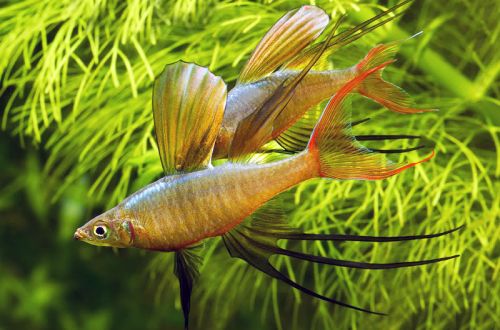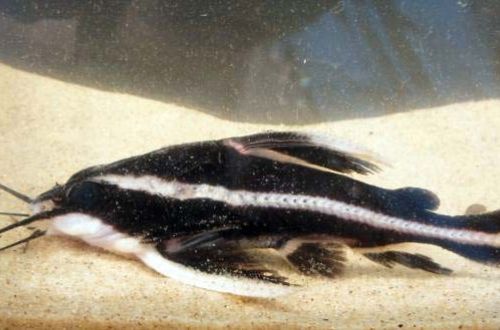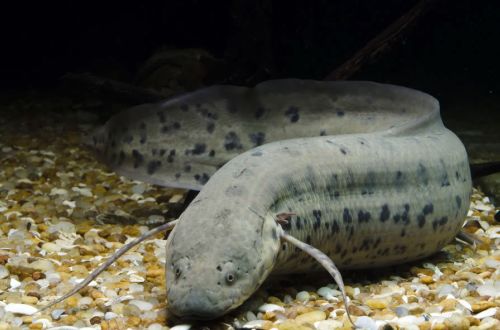
Rainbow Werner
Werner’s Iriatherina or Werner’s Rainbow, scientific name Iriatherina werneri, belongs to the Melanotaeniidae family. A beautiful amazing fish that you will not confuse with any other species. Relatively easy to keep and breed. It is recommended to keep in a species aquarium, or carefully consider the selection of neighbors who will not pose a threat to such unusual fins.

Contents
Habitat
It comes from the Indonesian islands and New Guinea, as well as from the humid regions of Australia. Such a wide habitat, consisting of many local islands, is explained by the fact that earlier this entire territory was a land isthmus from Eurasia to Australia. Relatively recently (by geological standards), with the end of the last ice age, almost the entire isthmus sank under water.
Inhabits shallow slow-moving rivers and streams, freshwater marshes, lagoons. Prefers regions with dense aquatic vegetation. Currently, exports from the wild have been reduced to a minimum, with the vast majority of fish bred commercially on fish farms.
Brief information:
- The volume of the aquarium – from 100 liters.
- Temperature – 22-30°C
- Value pH — 5.0–8.0
- Water hardness – soft (1-12 dGH)
- Substrate type – any
- Lighting – subdued
- Brackish water – no
- Water movement is weak
- The size of the fish is up to 4 cm.
- Meals – mostly meat
- Temperament – peaceful
- Keeping a group in the ratio of one male and 3–4 females
Description
Adults reach a length of about 3-4 cm. This is one of the most recognizable fish species due to the unusual shape of the fins, while males have much longer fins than females. The coloration is yellow-green, the lower part of the body and tail have a reddish tint.
Food
The diet should include a combination of meat and vegetable products, such as live or frozen brine shrimp, daphnia, spirulina flakes, etc. Alternatively, you can use dry food from well-known manufacturers with a high protein content.
Maintenance and care, arrangement of the aquarium
The size of the aquarium for a group of fish of 8-10 individuals starts from 100 liters. The design should use dense clusters of rooting and floating plants and a few snags in the form of branches and tree roots.
In the process of arranging an aquarium, it is worth remembering that Werner’s Rainbow does not tolerate excessive movement of water, so install equipment (primarily filters) in such a way as to minimize possible internal flow. Otherwise, the fish is quite unpretentious, able to successfully adapt to a wide range of pH and dGH values, hydrochemical parameters and temperature.
Behavior and Compatibility
Peaceful and friendly species able to get along well with many fish of comparable size and temperament. However, it should be borne in mind that the elongated fins of Iriatherina Werner males can become an irresistible temptation for fish such as Barbs, so it is necessary to pay great attention to the selection of neighbors.
Intraspecific relationships are built on the dominance of the alpha male in a certain territory, with the joint maintenance of two or more males, they will begin to compete with each other for the attention of females. This rivalry rarely leads to real injuries. It is recommended to purchase a group of 10 or more individuals in the ratio of 1 male to 3-4 females.
Breeding / breeding
The stimulus for the beginning of the mating season is the establishment of water temperature near the upper permissible limit. Spawning lasts several days, the female lays eggs in batches, and different males can fertilize them. The fish scatter their eggs near dense clusters of vegetation, which will later become their only defense. Parental instincts are not developed, so adult fish can enjoy their own eggs and fry with pleasure.
In order to preserve the offspring, the eggs can be moved in a timely manner to a separate tank with identical water conditions, equipped with a simple sponge filter. The design should also include various small-leaved plants and mosses or artificial analogues.
If the general aquarium is set up properly, then the fry are able to grow to an adult state in it. The presence of dense floating vegetation will play a decisive role here, since at an early stage of life the offspring spends near the surface.
Fish diseases
Health problems arise only in case of injuries or when kept in unsuitable conditions, which depresses the immune system and, as a result, provokes the occurrence of any disease. In the event of the appearance of the first symptoms, first of all, it is necessary to check the water for the excess of certain indicators or the presence of dangerous concentrations of toxic substances (nitrites, nitrates, ammonium, etc.). If deviations are found, bring all values back to normal and only then proceed with treatment. Read more about symptoms and treatments in the Aquarium Fish Diseases section.





